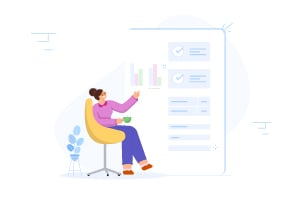As a CIO or BTP, you are frequently tasked with overseeing software development projects. Traditional methods like the Waterfall model may not always align with your objectives, especially when speed and flexibility are paramount. The Waterfall approach, while orderly and structured, lacks the adaptability to accommodate continuous iteration based on feedback, potentially leading to time-consuming revisions.
Enter the Rapid Application Development (RAD) framework, pioneered by James Martin in 1991. Despite its age, RAD tools remains popular among those seeking agile, responsive strategies for application development, and it's easy to see why. It prioritizes rapid product development, regular iterations based on feedback, and swift deployment of updated versions.
As a technology leader, adopting such methodologies can help you stay ahead of the curve and deliver value more efficiently.
What is Rapid Framework?
Rapid Framework is a collection of libraries, methods, classes, and reusable objects that follow the rapid application development paradigm. RAD frameworks help developers save time by organizing and streamlining their work. Frameworks save time by eliminating the need to create libraries and methods from scratch using an app development platform.
What are the stages of RAD Framework?
The RAD framework is divided into four stages:
- Phase 1: Requirements planning
- Phase 2: User design
- Phase 3: Rapid construction
- Phase 4: Cutover
Requirements planning:
Clients and the project team establish the future system’s goals at this phase. The emphasis is on achieving commercial objectives, and the criteria are relatively amorphous. It’s crucial to be able to alter or change them throughout the prototype stage.
The following is a basic summary of this stage:
- Analyzing the present issue
- Defining the project’s needs
- Getting last minute approval on different criteria from every stakeholder
Everyone must have a chance to assess the project’s standards and outcomes and provide feedback. Teams may avoid miscommunications and pricey variation orders down the line by obtaining agreement from each important stakeholder and programmer.
User design:
Once the project has been scoped out, it’s time to go to work on developing the user interface through several prototype iterations.
The RAD methodology’s meat and potatoes and what sets it distinct from other project management strategies is this. During this process, clients collaborate with developers to ensure that their needs are met at every stage of the design process. It’s similar to custom software development where users can test each prototype of the product at each stage to ensure it meets their standards.
In the iterative process, all of the flaws and kinks are ironed out. The developer creates a model, the customer (user) tests it, and then both parties meet to discuss what succeeded and what didn’t.
This technique allows programmers to change the model as they go until they find a design that they like. The users are shown the prototype once it has been completed. The team gathers all available feedback, and it is at this point those original needs are subject to alteration. Something that looked good on paper may appear very different in practice. With this information in hand, programmers return to the prototype stage until the users are happy.
Rapid construction:
We now have a clear picture of what has to be done. It’s time to finish developing and testing the RAD system so it can go into production. There will be no more cutting shortcuts; instead, the emphasis will be on quality, adaptability, and ease of maintenance. Users, on the other hand, continue to interact even at this late stage, offering input when new features are added. Depending on the tool used and other circumstances, what’s produced at the prototype stage may potentially be discarded.
The phase is divided into numerous smaller steps:
- Construction planning for a quick start
- Development of programs and applications
- Programming
- Testing at the unit, integration, and system levels
Throughout this stage, the software development team of coders, programmers, auditors, and developers collaborate to ensure that everything is running well and that the end product meets the client’s expectations and goals.
This third step is critical since the customer may still provide feedback throughout the method. They can provide modifications, adjustments, or even new ideas to tackle problems as they occur.
Cutover:
This is the stage when the final work is ready to be released. Data translation, testing, and the switchover to the new system, as well as user training, are all part of this stage. Once the product has been authorized, programmers apply the finishing touches such as testing, conversion, interface, or user training. Once the product has been adequately evaluated for criteria such as stability and lifespan, it is ready for delivery.
An example of RAD for Purchase Orders
Collecting data for purchase orders and approving them sounds like a very simple process, but readymade options often complicate it. However, you also want to build them on a platform that gives you more than just basic functionality.
To start this RAD example, gather all the people who know the process best, starting with the procurement team. Bring together current forms and a complete understanding of the workflow. Discuss how you want the app to function. With purchase orders, it’s often helpful to also have a vendor database for quick reference to call up information in the form.
Decide what fields should be shown at what steps and if you want to add some conditional steps that only happen when certain parameters are met.
Then, the procurement team can sit alongside someone familiar with Kissflow to build the first prototype. You should be able to have a working form and workflow built within 1-2 hours, depending on the complexity of your form and how many databases you want to link it to.
After getting the basic app up and running, it should be shared with those who are going to be using it. Those requesting purchase orders may have some additional ideas for improving the form or workflow. These changes can be implemented immediately and shown to stakeholders on the spot.
Wrapping up
Utilizing a rapid application development platform can significantly streamline the process of building your application. It's not just about making coding easier for developers but also about accelerating the overall development process. You're freeing yourself from the constraints of excessive paperwork. Whether you're already a fervent advocate of speedy methodologies or just dipping your toes into the concept, there's no denying that the RAD approach can boost project efficiency, ensure timely delivery, and enhance customer satisfaction through prompt execution.













